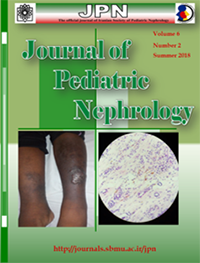Clinical and Microbiological Profile of Children with Urinary Tract Infection
Journal of Pediatric Nephrology,
Vol. 6 No. 2 (2018),
4 August 2018
,
Page 1-5
https://doi.org/10.22037/jpn.v6i2.21010
Abstract
Introduction: Urinary tract infection is one of the common bacterial infections seen in infants and children. As children present with non-specific symptoms, a diagnosis of UTI is often missed or it is diagnosed very late. A wide range of organisms with varying antibiotic sensitivity patterns have been known to cause UTI. The objectives of the study were:
- To study the clinical profile of children with UTI
- To study the microbiological profile of children with UTI
- To study the antibiotic resistance profile of various organisms causing urinary tract infection in children.
Materials and Methods: A retrospective Study was conducted in the Department of Pediatrics, CHRI, for 2 years from Jan 2014 to December 2016. The data of the children who met the inclusion criteria were collected from the case records. The collected data was tabulated and analyzed using IBM SPSS version 21.
Results: Males comprised a higher proportion of subjects in <1 year and 1-5 years when compared to females. Fever was the most common presenting symptom in the study population, which was seen in 220 (80.8%) children. The number of children with a positive culture for E.coli was 154 (56.0%) and Klebsiella was isolated in 37 (13.45%) children. A high proportion of E coli and Klebsiella species showed resistance to beta lactams and fluoroquinolones. E.coli was the most common organism in all age groups. The proportion of females was higher in the E. coli group (58.9%). Klebsiella had the highest proportion of resistance to more than 2 drugs (82.4%).
Conclusions: The most common age group affected by urinary tract infection is below 1 year with a male preponderance followed by above 5 years with a female preponderance. The most common isolated organism in all age groups was E. coli, which was found to be resistant to beta lactams and fluoroquinolones. Therefore, in any child with suspected, it is advised to start empirical therapy with an antibiotic, like amikacin and nitrofurantoin, and wait for the results of urine culture and sensitivity testing.
Keywords: Urinary Tract Infections; Child; Clinical; Microbiological.
- kidney
- infection
- organism
How to Cite
References
Indian Society of Pediatric Nephrology, Vijayakumar M, Kanitkar M, Nammalwar BR, Bagga A. Revised Statement on Management of Urinary Tract Infections. Indian Pediatr 2011;48:709-717.
Chang SL, Shortliffe LD. Pediatric urinary tract infections. Pediatr Clin North Am. 2006;53:379-400
American Academy of Pediatrics, Committee on Quality Improvement, Subcommittee on Urinary Tract Infections. Practice parameters: The diagnosis, treatment and evaluation of the initial urinary tract infections in febrile infants and young children. Pediatrics. 1999;103:843-52.
Nammalwar BR, Vijayakumar M, Sankar J, Ramnath B, Prahlad N. Evaluation of the use of DMSA in culture positive UTI and culture negative acute pyelonephritis. Indian Pediatr. 2005;42:691-6.
Narasimhan KL, Chowdhary SK, Kaur B, Mittal BR, Bhattacharya A. Factors affecting renal scarring in posterior urethral valves. J Pediatr Urol 2006; 2 : 569-74.
Narasimhan KL, Mahajan JK, Kaur B, Mittal BR, Bhattacharya A. The vesicoureteral reflux dysplasia syndrome in patients with posterior urethral valves. J Urol 2005; 174:1433-5.
Chandrasekharam VV, Srinivas M, Charles AR, Agarwala S, Mitra DK, Bal CS, et al. Urinary-tract infection affects somatic growth in unilateral symptomatic hydronephrosis. Pediatr Surg Int 2002; 18 : 451-4.
Smellie JM, Prescod NP, Shaw PJ, Risdon RA, Bryant TN. Childhood reflux and urinary infection: a follow-up of 10–41 years in 226 adults. Pediatr Nephrol. 1998;12:727-36.
Bays, A. G and Anadeto, F. Clinical and Laboratory Profile of Urinary Tract Infection among Children at the Outpatient Clinic of a Tertiary Hospital. PIDSP Journal 2010;11(1):10- 16.
Dnyaneshwari Purushottam Ghadage et al., Study of Etiology and Antibiogram of Uropathogens in Children-A Retrospective Analysis. Journal of Clinical and Diagnostic Research. 2014 Jan, Vol-8(1): 20-22.
AM Qureshi. Organisms Causing Urinary Tract Infection in Pediatric Patients at Ayub Teaching Hospital Abbottabad. J Ayub Med Coll Abbottabad 2005;17(1):72-74.
Taneja N, Sekhar Chatterjee S, Singh M, Singh S, Sharma M. Pediatric urinary tract infections in a tertiary care centre from north India. Indian J Med Res. 2010;131:101-105.
Sharma A, Shrestha S, Upadhyay S, Rijal P. Clinical and Bacteriological profile of urinary tract infection in children at Nepal Medical College Teaching Hospital. Nepal Med Coll J 2011;13(1):24-26.
Singh SD, Madhup SK. Clinical Profile and Antibiotics Sen¬sitivity in Childhood Urinary Tract Infection at Dhulikhel Hospital. Kathmandu Univ Med J 2013;44(4):319-324.
Manohar B, Jayachandra Naidu T, Sushma M. N. J., et al. Clinical Profile and Outcome of Urinary Tract Infections in Children Aged 1-12 Years. Journal of Evidence based Medicine and Healthcare 2015;2(18):2666-2674.
- Abstract Viewed: 635 times
- PDF Downloaded: 456 times

